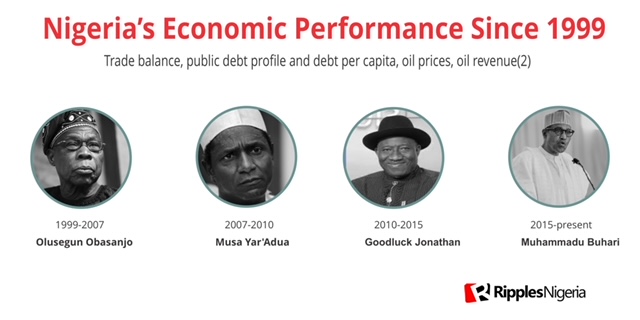Ripples Metrics
Ripplesmetrics: Nigeria’s key economic trends, as Buhari’s aides label Obasanjo failure (2)

This is the concluding part of comparison of how the Nigerian economy has performed under the administration of Olusegun Obasanjo, Umaru Musa Yar’Adua, Goodluck Ebele Jonathan and Muhammadu Buhari
In the earlier report, RipplesMetrics looked at the GDP growth rate, inflation, employment, exchange rate and foreign reserves.
In this week’s report, public debt profile and debt per capita, and also oil prices under each president will be analyzed.
Public debt profile
Nigeria’s rising debt profile has been a major issue in recent years. Despite securing debt relief during the Olusegun Obasanjo-led administration, successive governments have continued on a borrowing spree.
Since 1999, the debt profile of Nigeria has surged by more than 700%.
Recently the Debt Management Office got many Nigerians worried as it announced that the debt could hit N77 trillion.
Debt per capital
This is a measure of how much debt a government has per citizen head.
Here’s a breakdown of how much debt burden each president left for citizens.
Crude oil prices
One major source of debate on the economic performance of President Muhammadu Buhari administration is that the previous administration enjoyed oil boom.
READ ALSO:RipplesMetrics: Nigeria’s key economic trends, as Buhari’s aides label Obasanjo failure (1)
Being the key income earner of foreign exchange and revenue, it is easy to understand why it is always referred to when discussing performance of presidents.
Buhari while on a one-day visit to Imo State in September 2022 disclosed that Nigeria earned an average of $100 per barrel from 1999 to 2015, but past leaders could not improve the country’s infrastructure.
Checks, however, have revealed this not to be true. Here is a breakdown of how much oil price averaged under each president.
Data from OPEC shows that as at 1999, crude oil price was about $17.4 per barrel. It further surged to $27.6 in 2000, and later dipped to $23.1 in 2001.
However, in 2002, oil prices increased slightly to $24.3 per barrel and in 2003, it was $28.1 per barrel and $36.5 per barrel in 2004.
Subsequently, crude oil prices rose to $50.5 per barrel in 2005, then $61 in 2006, $69 in 2007 and $94.1 in 2008.
However, oil prices dropped to $60.8 per barrel in 2009 and in 2010, oil price surged to $77.3.
In 2011, the average annual price of oil had gotten to a record high of $107 per barrel, and later increased to $109 per barrel in 2012, $105.8 in 2013 but dropped $96.2 in 2014.
In 2015 before President Muhammadu Buhari came on board, crude oil prices hovered around $62 to $66 per barrel.
In 2022, thanks to Russia-Ukraine war, crude oil prices rose to over $100.
It is still currently above $80 in 2023.
Join the conversation
Support Ripples Nigeria, hold up solutions journalism
Balanced, fearless journalism driven by data comes at huge financial costs.
As a media platform, we hold leadership accountable and will not trade the right to press freedom and free speech for a piece of cake.
If you like what we do, and are ready to uphold solutions journalism, kindly donate to the Ripples Nigeria cause.
Your support would help to ensure that citizens and institutions continue to have free access to credible and reliable information for societal development.






















